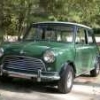Distributor (dizzy?) Questions- Newbie
#1

Posted 22 November 2009 - 01:49 PM
Year:1972
Car requires minutes of cranking to start in "cold" (45 deg. F) weather; Ignition?:
So, my mini has a motor from a Morris Metro (my motor was turbocharged at one time but is no longer).
I almost got stuck at work the other day b/c the car nearly failed to start. It was the first time I had ever tried to start it in temps below, say, 50 degrees F. The car is new to me. It starts pretty well above 50 deg F, & runs pretty well once it is started no matter the temp. Choke seems to work properly, etc. It is a 1275 bored out to 1293, may have a lumpy cam. Loud exhaust...
So I figured I'd check out the ignition system. It has a Lucas distributor, but I can't tell what type. The cap is held on with 2 spring clips (rather loosely, by the way; I can twist in several degrees with little effort- there is no clocking feature besides these 2 soft spring clips- is this normal??)
Anyway, the rotor is blue and symmetrical. It looks like the DRB104C advertised on GBparts.com. This is the accompanying text: "GRA2114 Distributor rotor for later Minis (1974+ up to electronic ignition) and Metros. Search for DDB108 if you also need the distributor cap. 45D & 59D distributors."
So maybe I have a 45D or 59D? 43D also looks similar in websites. Could it be that? How do I tell? I can't find much in the way of markings. Using 2 mirrors & my digital camera, I *think* I made out a "32D" on the bottor of the dizzy, but I see that that is not one of the regular choices.
The innards do not look like anything in my Haynes manual.
The second part of my question is what do I do with the distributor? The end of the rotor has some black discoloration and pitting on the end (not severe, though, I would say). The inside of the distributor cap where the rotor sparks to the metal for each of the cylinders shows signs of scarring (ie physical contact) on some of them.
And as for points, well, I don't even know where they are or how to get to them to inspect.
I am obviously very new to this. My idea is to refurb the the thing, maybe add an electronic ignitor for reliability ("never change points again" ??)
But to do all this I need to know what distributor I have, and how to inspect the bits that need inspecting, etc. Any insight as to whether I am attacking the right item would also be appreciated. (and by the way the spark plugs & ignition wires look pretty good).
Thanks for your help!!! This forum is great!
#2

Posted 22 November 2009 - 02:27 PM
1) Where are points? Maybe it already has electronic ignition?
 Haloween_plus_054_where_are_points_small.JPG 137.11K
27 downloads
Haloween_plus_054_where_are_points_small.JPG 137.11K
27 downloads2) Dizzy cap scarred
 Haloween_plus_060_Cap_Scarred_small.JPG 138.8K
22 downloads
Haloween_plus_060_Cap_Scarred_small.JPG 138.8K
22 downloads3) Rotor Dark
 Haloween_plus_062_Rotor_Dark_small.JPG 63.53K
17 downloads
Haloween_plus_062_Rotor_Dark_small.JPG 63.53K
17 downloads4) Rotor pitted
 Haloween_plus_063_Rotor_Pitted_small.JPG 67.16K
18 downloads
Haloween_plus_063_Rotor_Pitted_small.JPG 67.16K
18 downloads
#3

Posted 22 November 2009 - 02:30 PM
 Haloween_plus_051_32D_mirror.jpg 55.12K
20 downloads
Haloween_plus_051_32D_mirror.jpg 55.12K
20 downloads
#4

Posted 22 November 2009 - 07:16 PM
The 43D distributor should be similar in appearance to the 45D but it will not have a vacuum advance on it. Yours does. I don't know if there ever was a factory electronic ignition version of the 43D.
Most Lucas dizzys will have their identification numbers stamped or molded in. Look carefully on the metal housing (all around). If nothing else you should find a 5 digit number (probably beginning with "4") stamped in the aluminum. You can use that to look up your distributor.
The blue rotor you have is the newer "epoxy" type that is reported to be better quality than the standard part. I have one in a 45D4 on a project car but that car is not on the road yet.
The wear you photographed on the tip of the rotor and the inside of the cap is fairly common and not really a worry. You can scrape off any debris or heavy deposits if they concern you. While the cap is off, check the center contact. It should be a spring loaded carbon brush. If it's missing or is bound in position, that will make starting difficult or impossible. Also check the cap for cracks and "lines" that could be carbon tracks. If there are any, replace the cap. See if you can start the car at night in a dimly lit place. Open the bonnet and watch the ignition components. Any sparks or similar that you observe will highlight components that need replacing.
On the west coast, you've got lots of choices for parts other than GB Parts. You've got Heritage Garage, Mini Mania, and Seven. Go further up the coast and you can buy some of the generic British parts from BP Northwest. In the same vane as BP Northwest, another source for generic parts would be Northwest Import Parts (both firms are in Oregon).
Sorry, I'm not sure of the significance of the numbers in the last photograph you posted.
#5

Posted 22 November 2009 - 08:14 PM
Also, never push the accelerator right to the floor when trying to start it, the throttle only lets more air in and dosn't give it any more fuel. A part throttle opening is sufficient.
Make sure coil connections are perfect and waterproofed with sealant or similar and you should have no problems starting.
#6

Posted 22 November 2009 - 11:25 PM
There's no concern about the ability to rotate the distributor cap fairly freely? Shouldn't there be some clocking mechanism besides those soft spring clamps? And the apparent occasional rubbing of the rotor also not a concern, I guess?
I'll try to figure out how to check the timing via other posts. That sounds promising. Also I'll look for sparks in the dark.
If anyone has any other ideas on why the car may be more difficult to start in the cold (and almost left me stranded), but starts fine above ~50 deg F, and also runs fine (more or less) once it is started, please let me know... Carb? [I will say that while it is warming up on cold days, it stumbles a little below 2000 RPM under load; I have to slip the clutch a bit to get the car going without the engine stuttering. Is this a clue?
#7

Posted 22 November 2009 - 11:52 PM
If you have an electric fuel pump, turn the ignition to the run position before cranking. Allow a second or two for pressure to build. Pull the choke out all the way and turn the key to the start position. My Mini will start very quickly if it is driven at least once daily. If it is not driven for a week at a time, it may take two or three attempts at cranking for it to catch. If the engine is still warm from running previously, no choke should be needed.
If this is a 45D distributor and cap, there should be a small tang on the cap to engage the dizzy body. It's not much. If the clips are tight, the small tang is enough to orient the cap properly. The marks you showed in your pictures looked more like normal arc erosion of the rotor and cap terminals than impact damage. I'll look at them again (larger) to see if I missed anything.
EDIT: GEEZE... don't try typing a post with a cat sitting in your lap. There's no telling what will end up on the screen.
#8

Posted 23 November 2009 - 05:37 AM
I also looked at the ignition in the dark while it was running. I saw blue rings around each spark plug! The rings were on the spark plug body itself, between the ceramic center & the metal outside. All 4 looked very consistent. Is this normal?? Seems like I'd rather have that energy going into a spark! I have new plugs on order, maybe that will fix it??
My distributor does not seem to have the small tang to hold it, so still not sure on that one. Maybe it is missing a part. It does have a small rectangular hole, but does not line up w/ anything on the distributor. On the plus side, I'm not sure it is affecting the timing, and certainly not as much as rotating the whole distributor wrt the engine (which is how I set the timing to 16 BTDC).
Thanks much!
#9

Posted 23 November 2009 - 01:02 PM
So your plugs have an aura? I'm not sure about what you are seeing. I was expecting you to say that you saw blue dancing around on the wires or on top of the dizzy cap or coil. Hopefully others will be able to tell you what they've seen.
You ordered plugs? There's nothing magic about the plugs the Mini needs. If you are using resistor wires, use "regular plugs". If you are using solid core wires, use resistor plugs. Some people on here like Champions, others like NGK. I have no preference. Your local parts store is likely to have what you need. Ask for Champion N9Y (or RN9Y for resistor plugs), or NGK BP6ES (I forget what they add to the part number for resistor plugs).
#10

Posted 23 November 2009 - 01:33 PM
#11

Posted 23 November 2009 - 04:57 PM
#12

Posted 24 November 2009 - 02:57 AM
So we'll see whether this 16 BTDC improves things... I'll adjust the idle up a bit as well.
Mixture is another thing I may need to get into at some point. Interior of exhaust is all black & sooty. Though exhaust itself is fairly transparent.
If anyone could explain the timing vs. ability of engine to turn over thing, I'd appreciate it. I have new battery.
Also, I can't tell solid from resistor wires. Mine say "7mm silicone 8-9". The plugs that are there now (and the ones I ordered) are NGK BP6ES. And if anyone knows whether those halos are normal or not, please chime in!
Thanks much!
#13

Posted 25 November 2009 - 05:27 AM
It especially does poorly while trying to accelerate.
Does this sound like a timing thing? Why would it get worse as the car warms up?
Hope this is resolved with a reversion to the more advance timing...
#14

Posted 25 November 2009 - 06:10 AM
1, get the engine warm,turn off
2, loosen the distributer locking nut slightly
3, re start the engine
4, turn the distributor slightly anti clocking until the
revs start to drop off and running is uneven
5, turn the distributor clockwise until it reachs fast idle
if you turn a bit more it should start to become uneven
turn it back until it smooths out.
6, try it at this, its what i do and mine starts on the first turn hot or cold
#15

Posted 25 November 2009 - 01:28 PM
If you do not have a multimeter, this is a handy tool to own. Even the cheap ones from Harbor Freight are worth having. They are inexpensive enough to throw in the boot of the car and useful for home projects as well. The easiest way to tell what type of wires you have is to place a multimeter in resistance mode and measure the resistance of the spark plug wires "end-to-end". A solid core wire (or one made with coiled wire inside) will measure near zero ohms. A resistive spark plug wire's resistance is a function of its length and the material used for the core. Its end-to-end resistance may be anywhere from 5,000 to 12,000 ohms.
Since your car is running badly with the advance at 16 BTDC you can always turn it back to 22. An alternative to the by-ear method and the low-speed method you've tried so far is to set the high-speed timing. Do you have a "regular" timing light or an "advance" timing light? The advance light will have adjustments (typically on the back) to allow you to change when the strobe light fires. That's what you need for setting high-speed timing.
To set the high-speed timing, connect your advance timing light as normal and bring the engine to operating temperature. Set the advance dial to zero and record the engine's advance at idle and your starting idle speed. Now turn the advance dial to "32". Use the idle speed screw on the carb to bring the engine to 4000 RPM. Turn the dizzy until the ZERO timing mark and pointer line up then tighten the dizzy back in place and return the engine to its normal idle RPM. (Note that the timing light was set to 32 and you were matching the engine's zero timing mark and pointer). Turn the light's advance knob back to zero and note what your engine's new idle advance is. Test drive the car, making it work hard by accelerating up hill in too high a gear. Listen for knocking and pinging. If you hear any, adjust the timing "down" in 2 degree steps and repeat your test drive until no knocking and pinging is heard.
If you set the high-speed timing like this you are setting the maximum spark advance your engine can handle for its current state of build, wear, and the grade of fuel you use. Since many Mini engines are far removed from their stock factory condition, this lets you determine the advance that is right for your particular installation.
1 user(s) are reading this topic
0 members, 1 guests, 0 anonymous users
















